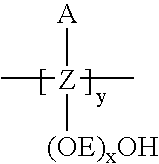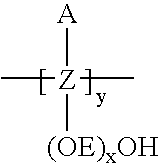Process for extracting bitumen
a bitumen and extraction technology, applied in the petroleum industry, liquid hydrocarbon mixture production, etc., can solve the problems of asphaltene and solids residues that cannot be removed from a vessel by conventional means, and the value of synthetic crude produced, so as to reduce foaming
- Summary
- Abstract
- Description
- Claims
- Application Information
AI Technical Summary
Benefits of technology
Problems solved by technology
Method used
Image
Examples
example 1
[0025]A cylindrical pot is filled with one part bitumen recovered from froth flotation of Albertan oilsand, several parts of a mixture of pentanes and hexanes, and 160 ppm of SEA1. SEA1 is an ethoxylated acid-catalyzed nonylphenol-formaldehyde condensate having about 50 percent ethylene oxide groups and a molecular weight of about 3000 Daltons (as measured chromatographically relative to polystyrene). The contents are heated to the process temperature then mechanically mixed. The tube is allowed to sit at the process temperature for several minutes until the insoluble materials settle to the bottom. A rotating rake-like spindle is used to measure the viscosity of the asphaltic sludge on the bottom of the pot. The asphaltic sludge is fluid. It is tested for foam formation and is found to have very little foaming relative to Comparative Example I. The results are shown below in the table.
example 2
[0026]Example 1 is repeated and tested substantially identically except that 480 part of SEA1 are used and the asphaltic sludge is not tested for foaming.
example 3
[0027]Example 2 is repeated and tested substantially identically except that 160 parts of SEA2 are used. SEA2 is an ethoxylated acid-catalyzed nonylphenol-formaldehyde condensate having about 60 percent ethylene oxide groups and a molecular weight of about 3000 Daltons. This Example was not effective at this concentration in this system.
PUM
| Property | Measurement | Unit |
|---|---|---|
| temperatures | aaaaa | aaaaa |
| weight percent | aaaaa | aaaaa |
| temperatures | aaaaa | aaaaa |
Abstract
Description
Claims
Application Information
 Login to View More
Login to View More - R&D
- Intellectual Property
- Life Sciences
- Materials
- Tech Scout
- Unparalleled Data Quality
- Higher Quality Content
- 60% Fewer Hallucinations
Browse by: Latest US Patents, China's latest patents, Technical Efficacy Thesaurus, Application Domain, Technology Topic, Popular Technical Reports.
© 2025 PatSnap. All rights reserved.Legal|Privacy policy|Modern Slavery Act Transparency Statement|Sitemap|About US| Contact US: help@patsnap.com


